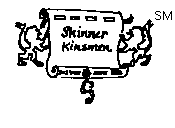

There is no proof without evidence
- Spring 1986
- Contents
- Appreciated Comments
- ChristChurch Cemetery,
- Diller Skinner Connection
- Domesday Project
- Gonzalez Skinner Connection
- Grandparent Paradox
- History of Eugene, OR (Chapter 2)
- Letter from Editor
- Lexington, KY Cemetery
- Malden, MA Library Gleanings
- Medical Genealogy
- miscSKINNERlaneous
- New Jersey Settlers (continued)
- New York Colony Marriage Liscenses
- Queries
- Regal Note of Thanks
- Resources
- Skinner Crests
- Aaron Nicholas Skinner
- Asahel Skinner Letter Postscript
- Edward Skinner Personal Memoirs
- Otis Skinner
- William Skinner Theory
- Zink - Skinner Connection
- Domesday Project
- Thanks to William Weiler
- for transcription of this article.
THE GRANDPARENT PARADOX
by Bill Skinner1
A commonly held notion: "we have two parents, four grandparents, eight great grandparents..." and so on ad infinitum. But do we? Is it true over a long period of time? It is completely safe to assume that no one can compute the exact figure. A listing of grandparents to the tenth generation would require a very large chart holding 1,024 names. Any attempt to go back 31 generations ends up in a lot of trouble. By assuming an average generation span of 33 years, we will have a figure that exceeds one billion grand parents by the time we reach the year 990 A. D. Authorities estimate it took several million years for the world population to reach one billion people. This occurred about the year 1830 A. D. At the beginning of the Christian era, world population was only about 250 million.2 So what happens to the doubling of past generations? The answer to this requires some figuring.
In the beginning, right from Adam and Eve, intra-marriage of family members was necessary to the continuation of the human race. As recent as Colonial America, when roads were few-and transportation difficult, communities were tightly drawn around family lines, and intra-marriage was more common than now. Often, husband and wife were cousins and shared the same grandparents. This situation has an amazing effect on the statistics of progenitors. Through the use of mathematics3, we can present examples of both sides of this discussion: one shows the number of forebears for JANE with no intra-marriages (which is quite impossible), and the other shows the same for MARY with only one intra-marriage (again, unlikely, but it suffices for this example):
Year
Number of Forebears
Number of Forbears
Difference
1980
JANE
MARY
1947
21 = 2
21 = 2
0
1914
22 = 4
22 = 4
0
1881
23 = 8
23 = 8
0
1848
24 = 16
24 = 16
0
1815
25 = 32
1.975 = 30
2
1782
26 = 64
1.976 = 58
6
1749
27 = 128
1.977 = 115
13
1716
28 = 256
l.978 = 227
27
1683
29 = 512
1.979 = 447
65
1650
210 = 1,024
1.9710 = 880
144
................
............................
..........
1485
215 = 32,768
1.9715 = 26,121
6647
................
............................
..........
1320
220 = 1,048,576
1.9720 =775,041
273,535
................
...........................
..........
990
230 = 1,073,741,700
1.9730 = 682,317,470
391,424,230
We began at year 1980, regressing 33 years for each preceding generation. At the 5th generation, we inserted figures that reflect cousins in MARY's line who married. This results in not a doubling to 32, but a change in the base number from 2 to 1.97, thus yielding 30 grandparents. Compounding this to the year 990 results in a reduction of forebears for MARY by a startling almost 391
................
lBorn in Nashville, TN, and majored in Marketing and Business Administration at the University of Tennessee. He is a veteran of the Korean War, has served with the General Electric Company for 30 years, and is a member of three genealogical societies and The Sons of the American Revolution. He has "dabbled" in family history for the past 25 years and seriously interested for the past 10 years.
2In the Human Interest, by Brown (W.W. Norton Co., 1974).
3Derived by Dr. Lee Smith, Professor of Chemistry at Limestone College, Gaffney, S.C. An accurate calculation of ancestry during and before 1815 for MARY (where maternal grandparents were second cousins) can be made by using the formula: 2n - 2n-4 where n= generation in ancestry.
NCGSJ - Feb 83